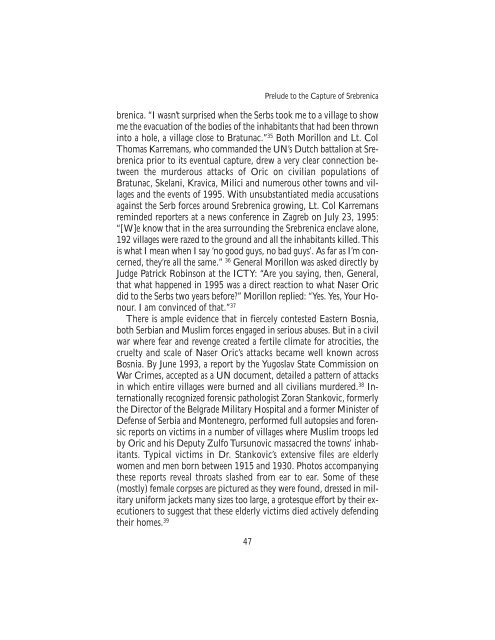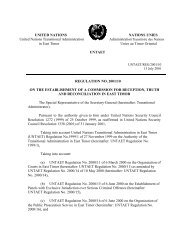The Srebrenica Massacre - Nova Srpska Politicka Misao
The Srebrenica Massacre - Nova Srpska Politicka Misao
The Srebrenica Massacre - Nova Srpska Politicka Misao
Create successful ePaper yourself
Turn your PDF publications into a flip-book with our unique Google optimized e-Paper software.
Prelude to the Capture of <strong>Srebrenica</strong><br />
brenica. “I wasn’t surprised when the Serbs took me to a village to show<br />
me the evacuation of the bodies of the inhabitants that had been thrown<br />
into a hole, a village close to Bratunac.” 35 Both Morillon and Lt. Col<br />
Thomas Karremans, who commanded the UN’s Dutch battalion at <strong>Srebrenica</strong><br />
prior to its eventual capture, drew a very clear connection between<br />
the murderous attacks of Oric on civilian populations of<br />
Bratunac, Skelani, Kravica, Milici and numerous other towns and villages<br />
and the events of 1995. With unsubstantiated media accusations<br />
against the Serb forces around <strong>Srebrenica</strong> growing, Lt. Col Karremans<br />
reminded reporters at a news conference in Zagreb on July 23, 1995:<br />
“[W]e know that in the area surrounding the <strong>Srebrenica</strong> enclave alone,<br />
192 villages were razed to the ground and all the inhabitants killed. This<br />
is what I mean when I say ‘no good guys, no bad guys’. As far as I’m concerned,<br />
they’re all the same.” 36 General Morillon was asked directly by<br />
Judge Patrick Robinson at the ICTY: “Are you saying, then, General,<br />
that what happened in 1995 was a direct reaction to what Naser Oric<br />
did to the Serbs two years before?” Morillon replied: “Yes. Yes, Your Honour.<br />
I am convinced of that.” 37<br />
<strong>The</strong>re is ample evidence that in fiercely contested Eastern Bosnia,<br />
both Serbian and Muslim forces engaged in serious abuses. But in a civil<br />
war where fear and revenge created a fertile climate for atrocities, the<br />
cruelty and scale of Naser Oric’s attacks became well known across<br />
Bosnia. By June 1993, a report by the Yugoslav State Commission on<br />
War Crimes, accepted as a UN document, detailed a pattern of attacks<br />
in which entire villages were burned and all civilians murdered. 38 Internationally<br />
recognized forensic pathologist Zoran Stankovic, formerly<br />
the Director of the Belgrade Military Hospital and a former Minister of<br />
Defense of Serbia and Montenegro, performed full autopsies and forensic<br />
reports on victims in a number of villages where Muslim troops led<br />
by Oric and his Deputy Zulfo Tursunovic massacred the towns’ inhabitants.<br />
Typical victims in Dr. Stankovic’s extensive files are elderly<br />
women and men born between 1915 and 1930. Photos accompanying<br />
these reports reveal throats slashed from ear to ear. Some of these<br />
(mostly) female corpses are pictured as they were found, dressed in military<br />
uniform jackets many sizes too large, a grotesque effort by their executioners<br />
to suggest that these elderly victims died actively defending<br />
their homes. 39<br />
47



